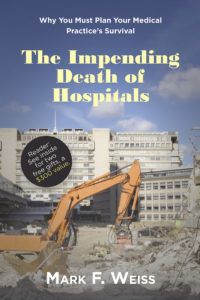I’ve yet to see a driverless car, but I bet that it’s headed to the funeral of some hospital.
Google’s driverless cars have logged over 100,000 miles without incident. I don’t know how many car drivers will want to give up the control, but I’d bet that large trucking companies are doing the calculations: fewer accidents, no caps on hours driven per day, and, most important, no drivers to pay.
And, I’m not talking twenty years out, I’m talking two or three years, max.
Technological leaps of the same magnitude are impacting healthcare and the pace is certain to increase. For example, robotics in hospitals, from the delivery of supplies to robot-assisted surgery will impact both the labor needs within a hospital and the potential location of the surgery and the surgeon (if one is needed at all). Or, for example, the miniaturization of equipment, including monitors.
Ponder what this means for the future of hospitals, at least in their present configuration. And ponder what it means, both in negative impact and in opportunities, for you.
Hospitals are, essentially, large factories. Those factories can be broken down into components. Chief among them are their main economic engine, the operating rooms, and their hotel-like, patient bed functions.
Compare this with freestanding ambulatory surgery centers. They’re hospitals minus the hotel functions.
So, if cars can drive themselves, trucks will be self-driving soon. And if trucks can self-drive, so can ambulances. And here’s the quite plausible leap: if ambulances can self-drive, so can, taking advantage of computerization, robotization and miniaturization, hospital rooms.
Imagine a hospital that’s akin to an ASC and an airport terminal. Patients are picked up at home in a shipping crate size, self contained, self-driving hospital room pod. The pod travels to the hospital and “docks.” The patient has the procedure inside the facility’s O.R., and returns to the pod.
The pod could be un-docked and shifted to an area adjacent to the building, and stacked and sorted robotically in the manner of shipping containers within a present day storage facility. When it’s safe to send the patient farther away from the hospital hub, the pod would be driven back to the patient’s home, where it would remain until discharge.
Due to the effects of miniaturization and remote monitoring, the patient would be under constant supervision, chiefly robotic but with some human participation. Some follow up procedures could be performed remotely. And, if a problem were to arise, there’d be no need to call an ambulance; the entire “room” would start driving to the hospital and could even be met part way by paramedics or other responders.
Or, for minor surgery, those procedures commonly performed today in an ASC, the entire O.R. and its now minimal staff could be contained in the pod and transported to the patient’s home. The procedure would take place and the patient then assisted back into their home; the “O.R.” would then drive to the next case. What’s lost in terms of case turnover is gained in term of huge reduction in operating expenses. Little staff, little space. In fact, if the procedure could be performed remotely or completely robotically, the notion of turnover time between cases might go the way of the covered wagon.
Sure, I could be wrong about some of this, but not all of this.
How will this impact referral patters? How will this impact where physicians work? How will this impact the notion of exclusive contracting or ACOs? Or, just as physicians branched out to ACOs taking procedures away from hospitals, will physician-owned mobile units obviate the need for hospitals themselves except for the most serious of surgical cases?
It’s not that the rules will be changing. The whole game will change.




